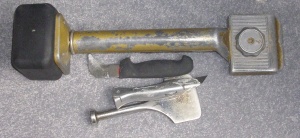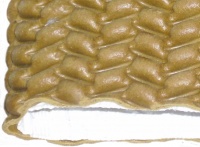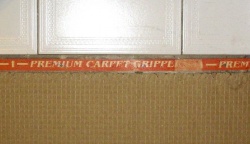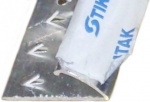Difference between revisions of "Carpet laying"
(→See also: tips link) |
(asstd small) |
||
| Line 19: | Line 19: | ||
==Underlay== | ==Underlay== | ||
[[image:Underlay 4514-3.jpg|right|200px]] | [[image:Underlay 4514-3.jpg|right|200px]] | ||
| + | |||
| + | Ribbed foam rubber underlay has long been used to provide a luxurious cushioned feel and hide floor defects. Foamed plastic underlay is also now available. | ||
Ribbed underlay is best laid with the flat side uppermost, ribs down. The flat side contains anti-stretching fibres to minimise carpet stretch when trodden on, helping to prolong carpet life. | Ribbed underlay is best laid with the flat side uppermost, ribs down. The flat side contains anti-stretching fibres to minimise carpet stretch when trodden on, helping to prolong carpet life. | ||
| − | Underlay can be fixed in place with a little spray glue, or just left unfixed, relying on carpet weight & friction. Both methods are used. When gluing its better to stick it to the carpet above rather than the floor underneath, it makes removal easier. | + | Underlay can be fixed in place with a little spray glue, or just left unfixed, relying on carpet weight & friction. Both methods are used. When gluing its better to stick it to the carpet above rather than the floor underneath, it makes removal easier. This is done by loose laying it, and applying glue to the top before laying down the top carpet. |
| + | |||
| + | Reusing old underlay is not a great idea. It may sometimes survive the life of the first carpet, but the odds of it also surviving a second carpet lifetime aren't good. The resulting lumps and depressions when the underlay disintegrates and the pieces move about do not create a good effect :) | ||
See [[Carpet]] re choice of underlays. | See [[Carpet]] re choice of underlays. | ||
| Line 52: | Line 56: | ||
When fitting underlay as well, gripper rods are the best option. | When fitting underlay as well, gripper rods are the best option. | ||
* These are only suitable for [[carpet]] plus an underlay. | * These are only suitable for [[carpet]] plus an underlay. | ||
| + | |||
===How grip rods work=== | ===How grip rods work=== | ||
| Line 59: | Line 64: | ||
# Underlay is laid out over the floor. It reaches the grip rod, or very close, but doesn't go over the top of it at all. | # Underlay is laid out over the floor. It reaches the grip rod, or very close, but doesn't go over the top of it at all. | ||
# Carpet is laid flat, smoothed. There are then 2 ways to fit it to the grip rods: | # Carpet is laid flat, smoothed. There are then 2 ways to fit it to the grip rods: | ||
| − | ## | + | ## Cut carpet to reach the wall plus half an inch. Whack it into the gap behind the grip rod using a wide bladed scraper (3-4" blade) (avoid one with sharp corners). This action pulls the carpet very slightly. Don't cut the carpet at 2 opposite walls before fitting it to the gripper, as fitting it moves the carpet slightly. |
| − | ## | + | ## Cut carpet to meet the wall. Stretch it half an inch with a knee kicker, and press it into the grip rod gap using a rounded [[Knives|knife]]. (The rounded back of a kitchen knife could be used if necessary.) |
| + | ## Don't cut the carpet first, whack it into the gripper rod gap using a scraper, then cut off the excess with a utility knife held at 45 degrees so the cut carpet edge is below the top of the carpet. | ||
| + | |||
===Fixing grip rods=== | ===Fixing grip rods=== | ||
| Line 66: | Line 73: | ||
* Grip rods are nailed to wooden floors. | * Grip rods are nailed to wooden floors. | ||
| − | * Grip rods will sometimes [[Nails|nail]] into to concrete floors (Hit the nails hard, and if more | + | * Grip rods will sometimes [[Nails|nail]] into to concrete floors (Hit the nails hard, and if more are needed use masonry nails) |
| − | * A quick setting [[glue]] may be used on concrete. 5 minute [[Glue|polyurethane]] is good, as shown. PVA is | + | * A quick setting [[glue]] may be used on concrete. 5 minute [[Glue|polyurethane]] is good, as shown. PVA is no use for this. |
| + | |||
===Spacing=== | ===Spacing=== | ||
| − | A quarter inch space from the wall is good for nearly all carpets. If the carpet's particularly thick or thin the gap can be adjusted. The point is that you can jam 2 layers of carpet fairly firmly between the grip rod and wall, and it'll hold secure. There's no universal formula to determine precise optimum spacing, carpet's fairly forgiving. | + | A quarter inch space from the wall is good for nearly all carpets. If the carpet's particularly thick or thin the gap can be adjusted. The point is that you can jam 2 layers of carpet fairly firmly between the grip rod and wall, and it'll hold secure. There's no universal formula to determine precise optimum spacing, and carpet's fairly forgiving. |
| + | |||
===Re-using grip rods=== | ===Re-using grip rods=== | ||
| − | A good | + | A good percentage of grip rods can be reused, but expect to replace some due to deterioration. |
* Check all are firmly fixed | * Check all are firmly fixed | ||
* Check for rusted carpet gripping [[nails]]. If found, replace the strip | * Check for rusted carpet gripping [[nails]]. If found, replace the strip | ||
| Line 79: | Line 88: | ||
* Clear muck out from the gap between grip rod and wall | * Clear muck out from the gap between grip rod and wall | ||
* If grip rods are in poor condition, spraying them with glue helps ensure the carpet sticks. | * If grip rods are in poor condition, spraying them with glue helps ensure the carpet sticks. | ||
| + | |||
===Re-using aluminium edging=== | ===Re-using aluminium edging=== | ||
| Line 98: | Line 108: | ||
# [[Hammer]] tacks in along the edges. Avoid [[Plumbing|pipes]] & [[Cable|wires]]! | # [[Hammer]] tacks in along the edges. Avoid [[Plumbing|pipes]] & [[Cable|wires]]! | ||
* Avoiding tacks that are unnecessarily long reduces the risk | * Avoiding tacks that are unnecessarily long reduces the risk | ||
| + | |||
==Glue== | ==Glue== | ||
| Line 145: | Line 156: | ||
===Pipe=== | ===Pipe=== | ||
Where a pipe comes out of the floor, just cut the carpet around it. No need for any fixings if its just a pipe upto 28mm. | Where a pipe comes out of the floor, just cut the carpet around it. No need for any fixings if its just a pipe upto 28mm. | ||
| + | |||
===Curved edges=== | ===Curved edges=== | ||
When carpeting round a curved item, such as a sink pedestal, fit several very short bits of grip rod to go round it. The quarter inch spacing need not be precise. | When carpeting round a curved item, such as a sink pedestal, fit several very short bits of grip rod to go round it. The quarter inch spacing need not be precise. | ||
| + | |||
===Carpet meets tiles=== | ===Carpet meets tiles=== | ||
| + | [[image:Underlay_laid_upto_griprod_4509-3.jpg|thumb|150px|Carpet to tiles]] | ||
| + | |||
The top of the tiles will be slightly higher than the floor getting carpeted, so use grip rod the same way as with walls. Sometimes glue is put into the gap between gripper and tile to reduce any risk of edge pullout. | The top of the tiles will be slightly higher than the floor getting carpeted, so use grip rod the same way as with walls. Sometimes glue is put into the gap between gripper and tile to reduce any risk of edge pullout. | ||
| + | |||
===Carpet meets bare floor=== | ===Carpet meets bare floor=== | ||
| Line 156: | Line 172: | ||
eg at doorways. Use an aluminium door strip like so | eg at doorways. Use an aluminium door strip like so | ||
| + | |||
===Carpet meets carpet=== | ===Carpet meets carpet=== | ||
| Line 161: | Line 178: | ||
Use an aluminium carpet to carpet door strip like so | Use an aluminium carpet to carpet door strip like so | ||
| + | |||
===Carpet meets vortex of hell=== | ===Carpet meets vortex of hell=== | ||
Sod the carpet | Sod the carpet | ||
| + | |||
===Step down threshold=== | ===Step down threshold=== | ||
| Line 210: | Line 229: | ||
* [[Glue]] | * [[Glue]] | ||
* [[Bad Ideas - Carpet]] | * [[Bad Ideas - Carpet]] | ||
| − | |||
* [[Special:Allpages|Wiki Article Index]] | * [[Special:Allpages|Wiki Article Index]] | ||
* [[Special:Categories|Wiki Subject Categories]] | * [[Special:Categories|Wiki Subject Categories]] | ||
Revision as of 06:14, 10 February 2012
For other info on carpets see Carpet
Floor defects
One of the functions of underlay is to hide floor defects. There are limits of course, but underlay can hide a 5mm gap.
Carpets laid with no underlay are much less forgiving of floor defects, and sometimes show up the ripple of every floorboard. Underlay is the usual recommendation, but there are other usable materials too, namely hardboard or old carpet.
- Old carpet works like underlay, though not quite as well
- Hardboard can resolve quite rough floors, can cover 28mm pipe holes, and blocks smoke ingress through floorboards in a fire
Concrete floors can have large gaps filled and cracks that change level smoothed with epoxy mortar.
- Where the cost of epoxy mortar is out of the question, ordinary cement mortar with lots of pva can be used, but its not very robust used like this. Brushing PVA onto it after filling the gaps helps.
- Levelling compound is also an option
Underlayments
Underlay
Ribbed foam rubber underlay has long been used to provide a luxurious cushioned feel and hide floor defects. Foamed plastic underlay is also now available.
Ribbed underlay is best laid with the flat side uppermost, ribs down. The flat side contains anti-stretching fibres to minimise carpet stretch when trodden on, helping to prolong carpet life.
Underlay can be fixed in place with a little spray glue, or just left unfixed, relying on carpet weight & friction. Both methods are used. When gluing its better to stick it to the carpet above rather than the floor underneath, it makes removal easier. This is done by loose laying it, and applying glue to the top before laying down the top carpet.
Reusing old underlay is not a great idea. It may sometimes survive the life of the first carpet, but the odds of it also surviving a second carpet lifetime aren't good. The resulting lumps and depressions when the underlay disintegrates and the pieces move about do not create a good effect :)
See Carpet re choice of underlays.
Newspaper
With foam rubber backed carpets, in time the rubber sticks itself to the floor, creating unnecessary work later. To minimise this its best to lay down newspaper first over the areas that don't need to be glued. Only a thin strip round the perimeter needs gluing down, the rest can be newspaper covered. This doesn't apply to any other carpet type.
Hardboard
Sometimes 3mm hardboard is laid down on top of floorboards. It can resolve quite rough floors, can cover 28mm pipe holes and board damage, and blocks smoke ingress through floorboards in a fire.
Old carpet
Old carpet can be used in lieu of new underlay when budget insists. Its not a perfect option, but its a lot better than no underlay, and I've not run into troubles using it.
- Used carpet doesn't yield as much as underlay when stepped on, but its far better than no underlay at all.
- The old carpet should be clean enough to avoid any risk of whiffs
- It supports the carpet less well than underlay, and a thin weak poor quality carpet could wear faster as a result.
- Pile pointing in one direction in the old carpet can worsen wrinkling on a loose carpet due to a tendency for the top layer to walk in one direction. Ensure the top carpet is properly fixed on all 4 sides, and not slack.
- This approach is not warranted by carpet manufacturers, who naturally wish to sell underlay, and it can void a guarantee claim.
- These are risk factors rather than anything that's going to happen, and in practice I've not run into any troubles using this approach.
Carpet Fixing methods
Gripper rods
When fitting underlay as well, gripper rods are the best option.
- These are only suitable for carpet plus an underlay.
How grip rods work
- Grip rods are fitted all round the floor perimeter, leaving a gap of about 1/4" between grip rod and walls. The pins point toward the wall, and the sloping edge goes nearest the wall.
- Underlay is laid out over the floor. It reaches the grip rod, or very close, but doesn't go over the top of it at all.
- Carpet is laid flat, smoothed. There are then 2 ways to fit it to the grip rods:
- Cut carpet to reach the wall plus half an inch. Whack it into the gap behind the grip rod using a wide bladed scraper (3-4" blade) (avoid one with sharp corners). This action pulls the carpet very slightly. Don't cut the carpet at 2 opposite walls before fitting it to the gripper, as fitting it moves the carpet slightly.
- Cut carpet to meet the wall. Stretch it half an inch with a knee kicker, and press it into the grip rod gap using a rounded knife. (The rounded back of a kitchen knife could be used if necessary.)
- Don't cut the carpet first, whack it into the gripper rod gap using a scraper, then cut off the excess with a utility knife held at 45 degrees so the cut carpet edge is below the top of the carpet.
Fixing grip rods
- Grip rods are nailed to wooden floors.
- Grip rods will sometimes nail into to concrete floors (Hit the nails hard, and if more are needed use masonry nails)
- A quick setting glue may be used on concrete. 5 minute polyurethane is good, as shown. PVA is no use for this.
Spacing
A quarter inch space from the wall is good for nearly all carpets. If the carpet's particularly thick or thin the gap can be adjusted. The point is that you can jam 2 layers of carpet fairly firmly between the grip rod and wall, and it'll hold secure. There's no universal formula to determine precise optimum spacing, and carpet's fairly forgiving.
Re-using grip rods
A good percentage of grip rods can be reused, but expect to replace some due to deterioration.
- Check all are firmly fixed
- Check for rusted carpet gripping nails. If found, replace the strip
- Check for buildup of muck on the top of the grip rod
- Clear muck out from the gap between grip rod and wall
- If grip rods are in poor condition, spraying them with glue helps ensure the carpet sticks.
Re-using aluminium edging
The spikes on used ali edging tend to be flattened down, and won't grip. Either:
- replace the edging strip
- spray glue into the strip and insert the carpet immediately.
- or even re-raise the spikes using a scraper or very small screwdriver.
Tacks
Tacking is cheap, but leaves a slighty wavy edge, and isn't as good at preventing fray as grip rods. Only a good option if you're broke.
- Tacks are only suitable for wooden floors.
- The tack points bend over in the wood to resist pullout.
- Lay carpet in place, and smooth carpet out to avoid wrinkles
- Cut carpet to walls
- Hammer tacks in along the edges. Avoid pipes & wires!
- Avoiding tacks that are unnecessarily long reduces the risk
Glue
Good option for foam & felt backed carpets
- Lay carpet in place, and smooth carpet out to avoid wrinkles
- Cut carpet to fit
- Peel back carpet edge, spray glue down and replace carpet. Done.
There are various carpet glues available
- spray solvent based glue - very quick set
- water based - slow to dry
- rubber resin - very tough
Tackifier
This is similar to glue, but remains permanently peelable. Ideal for carpet tiles where you want to be able to replace one if it gets damaged.
- Apply by brush or roller
- Let it set before laying the carpet
Tape
For foam & felt backed carpets
- lay tough double sided carpet tape down
- Lay carpet in place, and smooth carpet out to avoid wrinkles
- Cut carpet to fit
- Peel back carpet edge, peel off tape covering strip, replace carpet. Simples.
Don't be tempted to use another tape type with adhesive that may creep over time.
Stair rods
Stair rods were once used to fix carpet to stairs. However their failure can cause a serious accident, so they should only be used as a secondary decorative fixing method.
- The carpet is tacked in place at top and bottom
- then stuck down on each side of the interior corners, ie on the rear of the treads and the bottom of the vertical pieces between the treads.
- a stair rod is fitted over the top of the carpet to the rear of each step. The carpet must be narrower than the rod assembly.
No fixing
The carpet is just laid down without fixing it. It then turns up at the edges, moves & wrinkles. Wrinkles and turnups are a trip hazard. Not recommended.
Detailing
Grip rods
Pipe
Where a pipe comes out of the floor, just cut the carpet around it. No need for any fixings if its just a pipe upto 28mm.
Curved edges
When carpeting round a curved item, such as a sink pedestal, fit several very short bits of grip rod to go round it. The quarter inch spacing need not be precise.
Carpet meets tiles
The top of the tiles will be slightly higher than the floor getting carpeted, so use grip rod the same way as with walls. Sometimes glue is put into the gap between gripper and tile to reduce any risk of edge pullout.
Carpet meets bare floor
eg at doorways. Use an aluminium door strip like so
Carpet meets carpet
Use an aluminium carpet to carpet door strip like so
Carpet meets vortex of hell
Sod the carpet
Step down threshold
In the diagrams below,
_ /__ is an aluminium door strip : is a grip rod
There are 2 ways to do this:
________________ floor
|
_ :| Here the carpet goes down the step
/_____| plus horizonally a very short distance
________________ floor
|
| Here the carpet goes down the step
_____:| and stops where it meets the floor
Missing a bit
If you end up missing a little piece of gripper, with nothing to replace it, don't worry. Just run both underlay and carpet right upto the wall there. Only do this for small lengths though, upto about 7".
Joining Carpet
If a join's necessary, use carpet tape. Don't use anything less tough, and don't use another tape type with an adhesive that creeps over time.
Pile loss
Some pile loss after fitting is normal with some carpets.
Oops!
If the worst happens and you find you've cut the carpet too short, all is not lost. Cut a strip to fill the gap, and glue it and the short carpet edge down, pressing the 2 pieces up together to minimise join visibility. Visibility is also minimised by having the pile pointing the same way on both pieces. If the join is at all noticeable, sticking loose pile loops into the glue in the join can help it disappear further.





